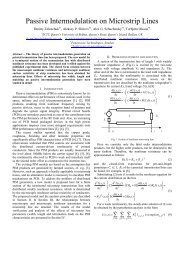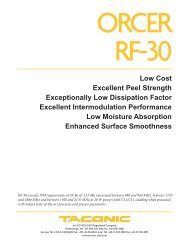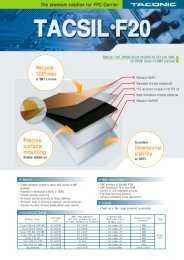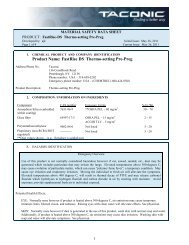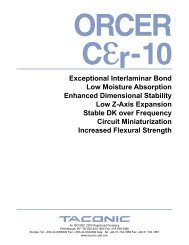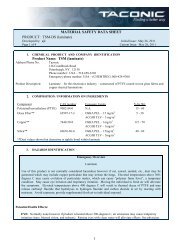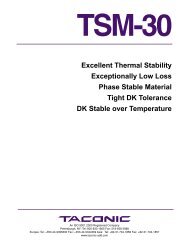COMPACT SLOT-LOADED PATCH ANTENNA FOR 868 ... - Taconic
COMPACT SLOT-LOADED PATCH ANTENNA FOR 868 ... - Taconic
COMPACT SLOT-LOADED PATCH ANTENNA FOR 868 ... - Taconic
Create successful ePaper yourself
Turn your PDF publications into a flip-book with our unique Google optimized e-Paper software.
2008 Loughborough Antennas & Propagation Conference 17-18 March 2008, Loughborough, UK<br />
Abstract:<br />
<strong>COMPACT</strong> <strong>SLOT</strong>-<strong>LOADED</strong> <strong>PATCH</strong> <strong>ANTENNA</strong> <strong>FOR</strong><br />
<strong>868</strong> MHz WIRELESS BODY AREA NETWORKS<br />
Anupam R. Chandran, Gareth A. Conway and William G. Scanlon<br />
Institute of Electronics, Communications & IT (ECIT)<br />
Queen’s University of Belfast, Queen’s Island<br />
Belfast, BT3 9DT, United Kingdom<br />
Email: a.ramachandran@qub.ac.uk<br />
Email: gconway03@ecit.qub.ac.uk<br />
Email: w.scanlon@qub.ac.uk<br />
The development of a compact and highly efficient antenna operating at <strong>868</strong> MHz for communication<br />
in ISM-band body area networks is reported. With symmetrical slots and shorting pins on either side<br />
of the feed, the antenna exhibited a radiation pattern similar to that of a monopole/dipole antenna with<br />
an efficiency of 52.3 % and an impedance bandwidth of 9.3 MHz (1.1 %) when placed in close<br />
proximity (1 mm) from a muscle tissue phantom. The maximum dimension of the proposed design is<br />
reduced by more than 66 % compared to a conventional λ/2 �microstrip patch antenna. Furthermore, for<br />
a simulated on-body path the performance of the new antenna was within 2 dB of a λ/4 monopole.<br />
1. Introduction<br />
Wearable electronic devices are becoming very popular in personal communications, computer<br />
systems and wireless monitoring of vital functions. For example, the preventative monitoring of a<br />
patient’s health is an application that often requires sensing devices in close proximity to the body.<br />
Therefore, there is an increasing demand for effective communication technologies to underpin<br />
emerging health care delivery systems such as telemonitoring where physicians can make informed<br />
decisions, monitor deterioration in chronic conditions, or assess the response of a patient to a specific<br />
treatment plan [1, 2].<br />
Wireless body area networks (WBAN) can be used to interconnect various components in a wearable<br />
computer or medical system. In terms of on-body communications, the main design criteria for<br />
WBAN modules are weight, physical size and power efficiency, all of which are directly related to<br />
antenna performance. Research interest in body mounted (wearable) antennas has rapidly increased in<br />
recent years including work on the use of flexible materials (textile antennas), both narrow/wideband<br />
antennas: microstrip patch, planar inverted F, dipole, ‘button’ type, and ultra wide band antennas [3–<br />
10]. In this paper, we present a compact, low-profile, slot-loaded planar microstrip patch antenna with<br />
radiation characteristics suitable for on-body communications and with relatively high radiation<br />
efficiency, taking account of the power absorbed in nearby body tissues.<br />
2. Antenna design and discussion<br />
Fig. 1 shows the geometry of the proposed antenna which is based on a previously reported higher<br />
mode microstrip patch antenna (HMMPA) specifically designed for on-body operation [10], with the<br />
addition of rectangular slots. The structure consists of a square patch of dimension ‘L’ with rectangular<br />
slots of width ‘w’ and length ‘l’, etched on a <strong>Taconic</strong> TLY-3 substrate material of thickness of ‘h’ and<br />
dielectric constant ‘εr’. ‘W’ denotes the dimension of the square ground plane. The antenna is excited<br />
using a probe of diameter 1.2 mm fed at the centre of the patch [10, 11]. Two shorting pins are used on<br />
either side of the feed. ‘S’ represents the distance between the shorting post from the feeding post. The<br />
distance between the shorting post and the slot is denoted by ‘U’.<br />
978-1-4244-1894-7/08/$25.00 ©2008 IEEE<br />
433
2008 Loughborough Antennas & Propagation Conference 17-18 March 2008, Loughborough, UK<br />
feed post<br />
shorting pin<br />
L<br />
l<br />
w<br />
W W<br />
S<br />
Fig. 1 Schematic of the proposed antenna. For <strong>868</strong> MHz, W = 60 mm, h = 10.5 mm, L = 41 mm, εr = 2.33,<br />
l = 30 mm, w = 2 mm, d = 1.2 mm, S = 2 mm, U = 3 mm.<br />
Fig. 2 shows the FDTD simulated return loss of the proposed antenna in free space. The 2:1<br />
impedance bandwidth was 4 MHz (0.5 %) with resonance at <strong>868</strong> MHz for the slotted patch. Without<br />
the slots, the antenna resonated at 930 MHz with an impedance bandwidth of 3.9 MHz (0.4 %).<br />
S 11 (dB)<br />
0<br />
-5<br />
-10<br />
-15<br />
-20<br />
-25<br />
-30<br />
In free space<br />
-35<br />
850 860 870 880 890 900 910 920 930 940 950<br />
Frequency (MHz)<br />
Fig. 2 Comparison of return loss for normal and slotted higher mode patch antenna in free space.<br />
By incorporating rectangular slots on either side of the shorting pin, the surface currents are forced to<br />
curve around the slots so as to increase the electrical length thus lowering the resonance frequency<br />
down to <strong>868</strong> MHz. The radiation efficiency of the antenna in free space was 88.6 % similar to the<br />
value for the un-slotted patch (89.1 %). The feeding point was chosen to be at the centre of the patch<br />
to obtain a symmetrical radiation pattern. This is particularly important for on-body wearable antennas<br />
since the orientation and placement of WBAN nodes is likely to vary in practice. Shorting pins on<br />
either side of the feed are used to match the input impedance of the antenna close to 50 Ω. The<br />
impedance is matched either by moving the shorting pins or by adjusting the thickness of the feed<br />
post. Reducing the thickness of the shorting pins results in a reduction in resonance frequency but the<br />
antenna becomes more sensitive to environmental factors such as antenna-body separation distance<br />
and it is also more difficult to find the optimum match, so the preferred approach is to vary the<br />
distance between the feed and the shortening pins. However, the resonance frequency can also be<br />
varied by changing the dimension of the slots. In this case the slots were at a distance of 5 mm from<br />
the feed post, which offered the maximum reduction in resonance frequency without affecting the<br />
impedance matching. Fig. 3 shows that the antenna radiates with a null in the boresight similar to that<br />
of a monopole with a peak directivity of 1.64 dBi. The surface current distribution shown in Fig. 4<br />
confirms that the highest currents are found surrounding the slots and at the feed post and shorting<br />
pins. Note that the resonating length of a conventional λ/2 microstrip patch antenna at <strong>868</strong> MHz<br />
should be 113.2 mm on a substrate with εr = 2.33, whereas the new slotted patch antenna is only<br />
41mm long at the same frequency (64 % smaller).<br />
U<br />
L<br />
Slotted Patch<br />
Un-Slotted Patch<br />
434<br />
h<br />
y<br />
z<br />
x
2008 Loughborough Antennas & Propagation Conference 17-18 March 2008, Loughborough, UK<br />
(a) (b)<br />
3. Tissue-Mounted Performance<br />
Z<br />
The effect on the radiation characteristics of the antenna placed in close proximity (1 mm) from a<br />
muscle tissue cuboid phantom of dimensions Lp = 400 mm, Wp = 400 mm and Hp = 60 mm was<br />
studied. The parameters used for the muscle tissue phantom at <strong>868</strong> MHz were εr = 56.032, σ =<br />
0.957 Sm -1 . However, since a probe feed is not practical for wearable applications the antenna was<br />
also modified so that the centre post was excited using a microstrip line. The microstrip feed was<br />
fabricated on a thin substrate of thickness h1 = 1 mm and εr = 2.33 for better coupling of the energy to<br />
the patch. The dimensions of the modified patch antenna were reduced compared to free space since<br />
the antenna was detuned when placed over the muscle tissue (by 21 MHz). The modified 38 mm x<br />
36.5 mm patch (Fig. 5) had a substrate thickness h2 = 9.5 mm and εr = 2.33 with 30 mm x 2 mm (l x<br />
w) slots. The diameter of all the three posts was 1.2 mm. The optimum impedance match was achieved<br />
by placing the two shorting posts 1.6 mm from the feed post.<br />
Substrate<br />
Y<br />
Fig. 3 Normalised co-polar (Ez) antenna directivity in free space a) elevation b) azimuthal.<br />
h2<br />
Patch<br />
0 dB<br />
-10 dB<br />
-20 dB<br />
-30 dB<br />
-40 dB<br />
-50 dB<br />
y<br />
Fig. 4 Surface current distribution.<br />
Fig. 5 Geometrical layout of the antenna with modified feed.<br />
Fig. 6 compares the on-phantom coupling performance of the new antenna with a reference λ/4<br />
monopole on the same size of groundplane. The height of the 1.2 mm diameter monopole was<br />
79.6 mm. The simulation setup consisted of two identical antennas mounted 200 mm apart on the<br />
cuboid phantom mentioned above. The radiation efficiency (taking account of both dielectric and<br />
tissue losses) of the slotted patch was 52.3 % compared to 65.4 % for the monopole. The return loss<br />
results in Fig. 6 demonstrate that the impedance bandwidth of the new antenna (9.3 MHz, 1.1%) is<br />
sufficient for ISM-band operation. In terms of on-phantom coupling (an important metric relating to<br />
the performance of an antenna for on-body links), the peak |S21| for the slotted patch was only 2 dB<br />
less (–17.6 dB c.f. –15.54) than for the monopole. Although the monopole retains a slight performance<br />
advantage, because of its height normal to the body surface it is inherently unsuitable for wearable<br />
applications.<br />
435<br />
x<br />
GND<br />
X<br />
h1<br />
Y<br />
SMA connector
2008 Loughborough Antennas & Propagation Conference 17-18 March 2008, Loughborough, UK<br />
Hp<br />
Frequency (MHz)<br />
Fig. 6. Simulation setup for antenna coupling on muscle tissue phantom, and comparison of slotted patch<br />
antenna and reference monopole return loss and |S21| coupling.<br />
4. Conclusions<br />
Tx D = 200 mm Rx<br />
Lp<br />
Wp<br />
A new compact low-profile antenna design for WBAN operation at <strong>868</strong> MHz is presented and studied<br />
using FDTD simulation. The antenna offers a significant size reduction with a maximum dimension of<br />
only 33.6 % compared to a conventional λ/2 microstrip patch antenna yet it maintains a relatively high<br />
efficiency of 52.3 % when placed in close proximity (1 mm) to a muscle tissue phantom at <strong>868</strong> MHz.<br />
Furthermore, the new antenna has an on-body coupling performance close to that of a full size<br />
monopole antenna mounted normal to the body surface. Overall, the new antenna had a relatively<br />
good performance considering its low profile nature (0.03λ) and small size of the antenna (0.11λ).<br />
Acknowledgement: This work was supported by EPSRC, grant ref. EP/D053749/01.<br />
dB<br />
On muscle tissue<br />
References<br />
[1] P. S. Hall, Y. Hao (eds). Antennas and Propagation for Body-Centric Wireless Communication. Artech<br />
House, Norwood, MA. (2006).<br />
[2] W.G. Scanlon, N. E. Evans and J. B. Burns, ‘FDTD Analysis of Close-Coupled 418 MHz Radiating Devices<br />
for Human Biotelemetry,’ Physics in Medicine and Biology, Vol. 44, No. 2, February 1999, pp. 335-345.<br />
[3] P. Salonen, Y. Rahmat-Samii and M. Kivikoski, ‘Wearable Antennas in the Vicinity of Human Body,’ IEEE<br />
Antennas and Propagation Society Symp., Vol.1, June 2004, pp. 467-470.<br />
[4] H. Adel, R. Wansch and C. Schmidt, ‘Antennas for a body area network,’ IEEE Antennas & Propagation<br />
Society. Intl. Symp., Vol 1, June 2003, pp. 471-474.<br />
[5] B. Sanz-Izquierdo, F. Huang and J. C. Batchelor, ‘Covert dual-band wearable button antenna,’ Electronics<br />
Letters. Vol. 42, No.12, June 2006, pp. 668-670.<br />
[6] M. Klemm, I. Z. Kovcs, G. F. Pedersen and G. Troester, ‘Novel Small-Size Directional Antenna for UWB<br />
WBAN/WPAN Applications,’ IEEE Trans. Antennas and Propagation, Vol.53, No.12, December 2005, pp.<br />
3884-3896.<br />
[7] H. E. King and J. L. Wong, ‘Effect of a Human Body on a Dipole Antenna at 450 and 900 MHz,’ IEEE<br />
Trans. Antennas and Propagation, Vol.25, No.3, May 1977, pp. 376-379.<br />
[8] W. G. Scanlon and N. E. Evans, ‘Numerical Analysis of Body worn UHF Antenna Systems,’ IEE<br />
Electronics and Communications Engineering Journal, Vol. 13, No. 2, April 2001, pp.56-64.<br />
[9] M. Klemm and G. Troester, ‘Textile UWB Antenna for Wireless Body Area Networks,’ IEEE Trans.<br />
Antennas and Propagation, Vol. 54, No. 11, November 2006, pp. 3192-3197.<br />
[10] G. A. Conway, W. G. Scanlon and D. Linton, ‘Low-profile microstrip patch antenna for over-body surface<br />
communication at 2.45 GHz,’ 65 th IEEE Vehicular Techn. Conf. VTC 2007-spring, April 2007, pp. 392-396.<br />
[11] Ch. Delaveaud, Ph. Leveque and B. Jecko, ‘New Kind of microstrip antenna: the monopolar wire-patch<br />
antenna,’ Electronics Letters. Vol.30, No.1 Jan. 1994, pp. 1-2.<br />
436<br />
0<br />
-10<br />
-20<br />
-30<br />
-40<br />
-50<br />
S11 dB Slotted patch<br />
S 12 dB Slotted patch<br />
S 11 dB Monopole<br />
S 12 dB Monoploe<br />
820 830 840 850 860 870 880 890 900 910



